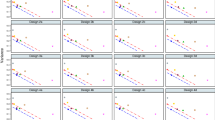Abstract
A new class of robust regression estimators is proposed that forms an alternative to traditional robust one-step estimators and that achieves the \(\sqrt{n}\) rate of convergence irrespective of the initial estimator under a wide range of distributional assumptions. The proposed reweighted least trimmed squares (RLTS) estimator employs data-dependent weights determined from an initial robust fit. Just like many existing one- and two-step robust methods, the RLTS estimator preserves robust properties of the initial robust estimate. However contrary to existing methods, the first-order asymptotic behavior of RLTS is independent of the initial estimate even if errors exhibit heteroscedasticity, asymmetry, or serial correlation. Moreover, we derive the asymptotic distribution of RLTS and show that it is asymptotically efficient for normally distributed errors. A simulation study documents benefits of these theoretical properties in finite samples.
Similar content being viewed by others
References
Aquaro M, Čížek P (2010) Two-step robust estimation of fixed-effects panel data models. CentER discussion paper, Tilburg University
Balke NS, Fomby TB (1994) Large shocks, small shocks, and economic fluctuations: outliers in macroeconomic time series. J Appl Econom 9:181–200
Baltagi BH, Jung BC, Song SH (2010) Testing for heteroskedasticity and serial correlation in a random effects panel data model. J Econom 154:122–124
Chen L-A, Chiang Y-C (1996) Symmetric quantile and symmetric trimmed mean for linear regression model. J Nonparametr Stat 7:171–185
Čížek P (2006) Least trimmed squares under dependence. J Stat Plan Inference 136:3967–3988
Čížek P (2008) General trimmed estimation: robust approach to nonlinear and limited dependent variable models. Econom Theory 24:1500–1529
Čížek P (2010) Reweighted least trimmed squares: an alternative to one-step estimators. CentER discussion paper 2010/91, Tilburg University, The Netherlands
Čížek P (2011) Efficient robust estimation of regression models. Comput Stat Data Anal 55:774–788
Davidson J (1994) Stochastic limit theory. Oxford University Press, New York
Davies PL, Gather U (2005) Breakdown and groups. Ann Stat 33:977–1035
De Long JB, Summers LH (1991) Equipment investment and economic growth. Q J Econ 106:445–501
Engler E, Nielsen B (2009) The empirical process of autoregressive residuals. Econom J 12(2):367–381
Genton MG, Lucas A (2003) Comprehensive definitions of breakdown points for independent and dependent observations. J R Stat Soc, Ser B 65:81–94
Gervini D, Yohai VJ (2002) A class of robust and fully efficient regression estimators. Ann Stat 30:583–616
Hampel FR, Ronchetti EM, Rousseeuw PJ, Stahel WA (1986) Robust statistics: the approach based on influence function. Wiley, New York
He X, Portnoy S (1992) Reweighted LS estimators converge at the same rate as the initial estimator. Ann Stat 20:2161–2167
Koenker RW, Bassett G (1978) Regression quantiles. Econometrica 46:33–50
Marazzi A, Yohai VJ (2004) Adaptively truncated maximum likelihood regression with asymmetric errors. J Stat Plan Inference 122:271–291
Preminger A, Franck R (2007) Foreign exchange rates: a robust regression approach. Int J Forecast 23:71–84
Ronchetti E, Trojani F (2001) Robust inference with GMM estimators. J Econom 101:37–69
Rousseeuw PJ (1984) Least median of squares regression. J Am Stat Assoc 79:871–880
Rousseeuw PJ (1985) Multivariate estimation with high breakdown point. In: Grossman W, Pflug G, Vincze I, Wertz W (eds) Mathematical statistics and applications, vol B. Reidel, Dordrecht, pp 283–297
Rousseeuw PJ, Leroy AM (1987) Robust regression and outlier detection. Wiley, New York
Rousseeuw PJ, Yohai VJ (1984) Robust regression by means of S-estimators. In: Franke J, Härdle W, Martin RD (eds) Robust and nonlinear time series analysis. Lecture notes in statistics, vol 26. Springer, New York, pp 256–272
Ruppert D, Carroll RJ (1980) Trimmed least squares estimation in the linear model. J Am Stat Assoc 75:828–838
Sakata S, White H (1998) High breakdown point conditional dispersion estimation with application to S&P 500 daily returns volatility. Econometrica 66:529–567
Simpson DG, Ruppert D, Carroll RJ (1992) On one-step GM estimates and stability of inferences in linear regression. J Am Stat Assoc 87:439–450
Stromberg AJ, Hössjer O, Hawkins DM (2000) The least trimmed difference regression estimator and alternatives. J Am Stat Assoc 95:853–864
Tableman M (1994) The influence functions for the least trimmed squares and the least trimmed absolute deviations estimators. Stat Probab Lett 19:329–337
Temple JRW (1998) Robustness tests of the augmented Solow model. J Appl Econom 13:361–375
Víšek JÁ (2002) The least weighted squares I. The asymptotic linearity of normal equations. Bull Czech Econom Soc 9(15):31–58
Welsh AH, Ronchetti E (2002) A journey in single steps: robust one-step M-estimation in linear regression. J Stat Plan Inference 103:287–310
Woo J (2003) Economic, political, and institutional determinants of public deficits. J Public Econ 87:387–426
Zaman A, Rousseeuw PJ, Orhan M (2001) Econometric applications of high-breakdown robust regression techniques. Econ Lett 71:1–8
Acknowledgement
This research was supported by grant GA ČR number 402/09/0557.
Author information
Authors and Affiliations
Corresponding author
Rights and permissions
About this article
Cite this article
Čížek, P. Reweighted least trimmed squares: an alternative to one-step estimators. TEST 22, 514–533 (2013). https://doi.org/10.1007/s11749-013-0335-5
Received:
Accepted:
Published:
Issue Date:
DOI: https://doi.org/10.1007/s11749-013-0335-5



